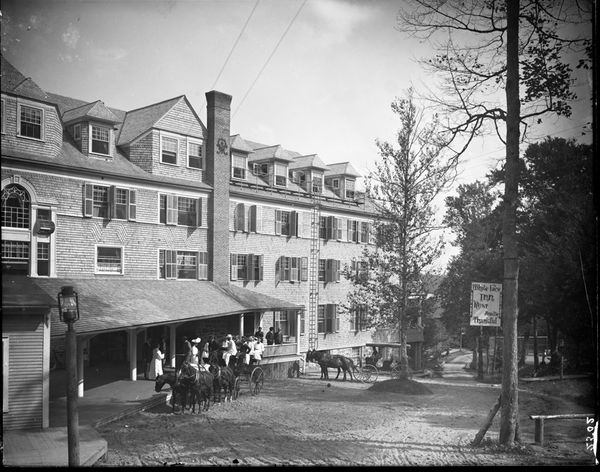By: Jennifer Tufano
While in the process of scanning thousands of glass plate negatives as part of an ongoing conservation project at the historical society, we came across some striking and elegant images of the Whiteface Inn. As a way to understand this elegant property, Mary MacKenzie offers the following answer to a question posed to her February 15, 1984 and can be found in The Plains of Abraham.
“The first hotel on the site of Whiteface Inn was called the Westside. Oliver Abel, a lawyer from Elizabethtown, New York built it early in 1882. At that time, the present road from the Saranac Lake road was not in existence, and all the building materials had to be taken over the lake on a barge or boat. One boat loaded with sand for construction purposes sank, and presumably is still lying on the bottom of the lake off what is now known as “Sand Point.”
The Westside opened on August 1, 1882. Its first guests were the Colburn family from Ansonia, Connecticut, who had been waiting with several of their friends at the Grand View Hotel, in Lake Placid, for the opening. The mountain behind the Westside was named Mount Colburn in their honor.
In 1891, the Abels sold the hotel and adjoining land of four hundred acres to the Adirondack Company, which had been organized in November 1890. Its first officers were E.B. Bartlett, president; A.G. Mills, vice president; and Preble Tucker, secretary and treasurer. The company renamed the hotel Whiteface Inn in February 1891. In 1896, the annex to the north of the old hotel was erected, as well as the Wigwam, a recreational building and bowling alley. Mrs. Mabel Child leased and managed the inn from 1896 until 1901 and was very successful.
In 1901, the original old Westside was torn down, and on its site, a new building was erected. In 1902, the cottages Inwood and Overbrook were built, and they still stand. A few years later, the inn was considerably enlarged.
On the night of May 20, 1909, the inn took fire and burned to the ground. It had survived only eight years. The Wigwam, although close to the inn, escaped harm and was used until 1932, when it was torn down. Balsams, Overlook, and Hillside cottages, and the laundry and stables, also, were unharmed.
From 1910 to 1914, Mr. Halsey Wood, caretaker at the inn, and his wife took care of a number of summer boarders each year, using the cottages spared by the fire. In the fall of 1914, the Adirondack Company began the erection of a new building, and Whiteface Inn reopened in the summer of 1915. A wing was added in 1916, doubling the inn’s capacity. This is the hotel building that still stands today. Many improvements were made over the years, of course, and a convention hall and heated swimming pool were added, along with many cottages.
The new inn was managed from its opening in 1915 through 1929 by James J. Sweeney, and from 1930 to 1954 by Henry W. Haines. Whiteface Inn Inc. acquired the property in 1954 and hired a managing director, F. Burton Fisher, who served until his retirement at the end of the 1970 season. During Mr. Fisher’s years, the hotel became a great center for conventions. He was an outstanding manager, and the hotel was a great success during his stewardship. After his departure, the place gradually declined. Perhaps it would have anyway, for these great old hotels have had to give way to the motel era. People no longer come to resorts to stay for the entire summer.
Incidentally, the original Whiteface Inn golf course was not the present one. I believe it was before 1900 that the Inn leased a piece of land now occupied by the W. Alton Jones Cell Science Center (*off Saranac Avenue and now closed) and had a nine-hole course there for some years. Golfers were transported from the inn to the golf course by horse-drawn carriage. Upon completion of the new inn in 1915, the company built a new nine-hole course on the outlying section of the present course on land where the great fire of 1903 had destroyed the forest. In the early 1930s, this course was converted into an eighteen-hole course by enlarging it and extending it toward the inn. The present golf house was built in 1963.”

